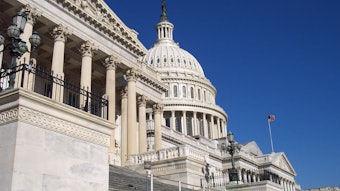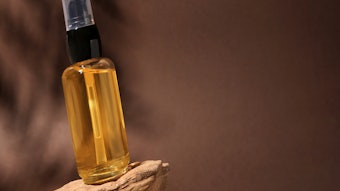
On Feb. 7, 2023, Assembly Bill 496 (AB496) was introduced proposing the addition of 26 chemicals to the state of California's existing Toxic-free Cosmetics Act. If passed, the bill would to ban the sale of cosmetics containing these compounds, which are linked to negative impacts on human health. According to the Environmental Working Group (EWG), the chemicals include some borate compounds, lily aldehyde, cyclotetrasiloxane, trichloroacetic acid, styrene and certain colors (see full list below).
“Personal care products and cosmetics should be non-toxic for everyone," said Assemblymember Laura Friedman (D-Burbank), in an EWG statement. "If you consider that the European Union prohibits over 1,600 chemicals in such products, a ban in California on these noxious carcinogens and endocrine disrupters is long overdue. AB 496 continues our progress toward cleaner, healthier, and environmentally-safer products.” Industry experts might argue that many of the chemicals banned from cosmetics sold in the EU are actually not used in cosmetics.
In 2022, Gov. Gavin Newsom also signed a law banning the sale of cosmetics in the state of California with additionally added PFAS. Five European nations and the European Chemicals Agency recently submitted a proposal to do the same in Europe; this is currently under review.
Originally, as previously reported, in 2020, Assembly Bill 2762, the Toxic-free Cosmetics Act, was signed into law in the state of California. The law established that beginning on Jan. 1, 2025, "no person or entity shall manufacture, sell, deliver, hold or offer for sale, in commerce any cosmetic product that contains any of the following 12 intentionally added ingredients..." (see below list); note that the law does provide for unavoidable trace contaminants that occur during manufacturing.
Cosmetics & Toiletries has reached out for comments on what the addition of these chemicals could mean for the industry. Follow us we watch the proposed bill unfold.
update: Debbie Waite, co-chief executive officer of Steinberg & Associates and a C&T magazine adviser, shared the following statement regarding the state of California's move.
"AB 496 is an update to the list of prohibited chemicals for cosmetic products and it follows the EU, which is not necessarily a good thing as the EU has such things as petroleum gases and dozens of petroleum distillates on its prohibited ingredient list. No one is going to use nasty petroleum gases or distillates in a product that is intended to make you look better (some highly refined petroleum distillates are used, but these are not prohibited).
"I took a look to see what might affect U.S. cosmetic companies and found the use for the 42 chemicals is very low in the industry overall. What disappoints me is having termite insecticides included in the list. No one is going to use that in a cosmetic. If California is going to prohibit chemicals, let's make it real and based on sound science."
Chemicals Named in Toxic-free Cosmetics Act
- Dibutyl phthalate (CAS no. 84-74-2);
- Diethylhexyl phthalate (CAS no. 117-81-7);
- Formaldehyde (CAS no. 50-00-0);
- Paraformaldehyde (CAS no. 30525-89-4);
- Methylene glycol (CAS no. 463-57-0);
- Quaternium-15 (CAS no. 51229-78-8);
- Mercury (CAS no. 7439-97-6);
- Isobutylparaben (CAS no. 4247-02-3);
- Isopropylparaben (CAS no. 4191-73-5);
- m-Phenylenediamine and its salts (CAS no. 108-45-2);
- o-Phenylenediamine and its salts (CAS no. 95-54-5); and
- Several per- and polyfluoroalkyl substances (PFAS) and their salts, namely:
a) Perfluorooctane sulfonate (PFOS); heptadecafluorooctane-1-sulfonic acid (CAS no. 1763-23-1)
b) Potassium perfluorooctanesulfonate; potassium heptadecafluorooctane-1-sulfonate (CAS no. 2795-39-3)
c) Diethanolamine perfluorooctane sulfonate (CAS 70225-14-8)
d) Ammonium perfluorooctane sulfonate; ammonium heptadecafluorooctanesulfonate (CAS 29081-56-9)
e) Lithium perfluorooctane sulfonate; lithium heptadecafluorooctanesulfonate (CAS 29457-72-5)
f) Perfluorooctanoic acid (PFOA)(CAS no. 335-67-1)
g) Ammonium pentadecafluorooctanoate (CAS no. 3825-26-1)
h) Nonadecafluorodecanoic acid (CAS no. 355-76-2)
i) Ammonium nonadecafluorodecanoate (CAS no. 3108-42-7)
j) Sodium nonadecafluorodecanoate (CAS no. 3830-45-3)
k) Perfluorononanoic acid (PFNA)(CAS no. 375-95-1)
l) Sodium heptadecafluorononanoate (CAS no. 21049-39-8) and
m) Ammonium perfluorononanoate (CAS no. 4149-60-4).
26 Proposed Additions
- Lily aldehyde (CAS no. 80-54-6);
- Acetaldehyde (CAS no. 75-07-0);
- Cyclohexylamine (CAS no. 108-91-8);
- Cyclotetrasiloxane (CAS no. 556-67-2)
- Phytonadione (CAS no. 84-80-0);
- Sodium perborate (CAS no. 15120-21-5);
- Styrene (CAS no. 100-42-5);
- Trichloroacetic acid (CAS no. 76-03-9);
- Tricresyl phosphate (CAS no. 1330-78-5);
- Vinyl acetate (CAS no. 108-05-4);
- 2-Chloracetamide (CAS no. 79-07-2);
- Allyl isothiocyanate (CAS no. 57-06-7);
- Anthraquinone (CAS no. 84-65-1);
- Malachite green (CAS no. 569-64-2);
- Oil from the seeds of Laurus nobilis L. (CAS no. line 5 84603-73-6);
- Pyrogallol (CAS no. 87-66-1);
- C.I. disperse blue 1 (CAS no. 2475-45-8);
- Trisodium nitrilotriacetate (CAS no. 5064-31-3);
- The following boron substances:
a) Perboric acids: i) sodium salt (CAS no. 11138-47-9), ii) sodium salt, monohydrate (CAS no. 12040-72-1), iii) sodium perborate monohydrate (CAS no. 10332-33-9);
b) Boric acid (CAS nos. 10043-35-3 and 11113-50-1);
c) Borates, tetraborates, octaborates and boric acid salts and esters, including all of the following: i) disodium octaborate anhydrous (CAS no. 12008-41-2), ii) disodium octaborate tetrahydrate (CAS no. 12280-03-4), iii) 2-aminoethanol, monoester with boric acid (CAS no. line 20 10377-81-8), iv) 2-hydroxypropyl ammonium dihydrogen orthoborate (CAS line 22 no. 68003-13-4), v) potassium borate, boric acid potassium salt (CAS no. line 24 12712-38-8), vi) trioctyldodecyl borate, vii) zinc borate (CAS no. 1332-07-6), viii) sodium borate, disodium tetraborate anhydrous; boric acid, sodium salt (CAS no. 1330-43-4), ix) tetraboron disodium heptaoxide, hydrate (CAS no. line 30 12267-73-1), x) orthoboric acid, sodium salt (CAS no. 13840-56-7), xi) disodium tetraborate decahydrate; borax decahydrate (CAS line 33 no. 1303-96-4), xii) disodium tetraborate pentahydrate; borax pentahydrate (CAS no. 12179-04-3) and xiii) disodium octaborate tetrahydrate (CAS no. 12280-03-4); - C.I. disperse blue 3 (CAS no. 2475-46-9);
- Basic green 1 (CAS no. 633-03-4);
- Basic blue 7 (CAS no. 2390-60-5);
- 3(or5)-((4-(benzylmethylamino)phenyl)azo)-1,2-(or1,4)-dimethyl-1H-1,2,4-triazolium and its salts (CAS nos. 89959-98-8 and 12221-69-1);
- Basic violet 4 (CAS no. 2390-59-2);
- Basic blue 3 (CAS no. 33203-82-6); and
- Basic blue 9 (CAS no. 61-73-4).










